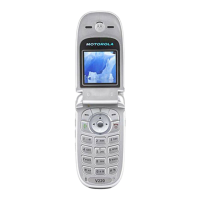
Do you have a question about the Motorola V220 and is the answer not in the manual?
| Display Type | CSTN, 65K colors |
|---|---|
| Main Camera | VGA |
| Battery Type | Removable Li-Ion 820 mAh battery |
| Network Technology | GSM |
| 2G bands | GSM 900 / 1800 / 1900 |
| GPRS | Class 10 |
| EDGE | No |
| Status | Discontinued |
| SIM | Mini-SIM |
| Loudspeaker | Yes |
| Alert types | Vibration; Downloadable polyphonic ringtones |
| Phonebook | 500 entries |
| Call records | 10 dialed, 10 received, 10 missed calls |
| Card slot | No |
| Camera | VGA |
| Radio | No |
| Messaging | SMS, EMS, MMS |
| Browser | WAP 2.0/xHTML |
| Games | Yes |
| Languages | Multiple |
| Java | No |
| Resolution | 128 x 160 pixels |
| Announced | 2004, Q4 |
| Colors | Silver |
Identifies and describes the function of each key on the Motorola V220 phone, including navigation and action buttons.
Provides an introduction to the user guide and its content.
Explains optional features and accessories for the Motorola V220 phone.
Instructions for inserting the SIM card into the phone and important precautions.
Details on battery performance, charging, storage, and disposal guidelines for optimal use.
Step-by-step guide for physically installing the battery and connecting the charger.
How to turn the phone on and off, and adjust earpiece and ringer volumes.
Basic procedures for initiating and receiving phone calls on the V220.
Instructions on how to check your own phone number stored on the SIM card.
Information on how the phone emits and receives RF energy and compliance with exposure guidelines.
Guidelines for optimal phone performance and safe usage, including external antenna care.
Procedures for maintaining RF energy exposure compliance during body-worn or data operations.
Information on using approved accessories and potential RF energy interference.
Safety instructions for using the phone in hospitals, healthcare facilities, and on aircraft.
Important safety advice for users with pacemakers or hearing aids to prevent interference.
Warnings and precautions for using the phone while driving and in hazardous environments.
Guidelines for safe handling, disposal, and potential hazards associated with phone batteries.
Information on photosensitivity, blinking lights, and ergonomic advice for prolonged phone use.
Statement regarding the product's compliance with EU directives and approval numbers.
Step-by-step instructions for using the phone's camera to capture and send photos.
How to compose, send, and receive multimedia messages with text, photos, and sounds.
Instructions on downloading, playing, and managing video clips on the phone.
Explains the home screen, status indicators, and how to navigate using the display.
Detailed guide on using the 5-way navigation key for menu navigation and selection.
Instructions on entering and navigating the main menu and its features.
How to select features from the menu and choose options from lists.
Guide to entering text, choosing between Primary, Numeric, iTAP, and Symbol methods.
Explains the functionality of the smart key and the features of the external display.
Procedure for changing phone unlock codes, security codes, PINs, and passwords.
How to switch between active phone lines for dual-SIM card users.
Methods for redialing numbers and enabling automatic redial for busy signals.
Information on how Caller ID displays incoming calls and how to manage outgoing call ID.
How to cancel an incoming call or turn off the call alert before answering.
Instructions for dialing emergency numbers, including limitations and country variations.
How to make international calls and access lists of recent incoming and outgoing calls.
How to return missed calls and use the notepad for storing numbers.
Methods for quickly dialing contacts using speed dial and one-touch dial features.
Instructions for listening to and storing voicemail messages.
Features for managing multiple calls, putting calls on hold, and transferring calls.
Overview of the phone's main menu structure, including categories like Phonebook, Messages, and Settings.
Detailed list of settings available under Personalise, Ring Styles, Call Divert, In-Call Setup, Initial Setup, and Security.
A quick guide to locating features not fully described in the manual.
Instructions for using Multimedia Messaging Service (MMS), Instant Messaging (IM), and Chat features.
How to create, manage, and dial entries in the phonebook, including ring ID and category settings.
Customising ring alerts, volumes, clock display, and menu appearance.
How to show/hide menu icons, change home screen keys, and create shortcuts.
Using fixed dialling, service numbers, and quick dial options for making calls.
Information on tracking call times, costs, and activating DTMF tones.
Using speakerphone, auto answer, voice dial, and car kit functionalities.
Instructions for connecting the phone to devices for data and fax transmission.
Managing network settings and using personal organiser features like Datebook and Alarms.
Using the calculator, currency converter, and security features like SIM PIN and application lock.
Accessing the micro-browser, downloading games, and managing pictures.
Explains the phone's compliance with international RF energy exposure limits and the SAR unit.
Details the SAR limit for the model, testing procedures, and factors affecting actual SAR levels.
States the highest SAR value for the model and explains the importance of governmental requirements for safe exposure.
